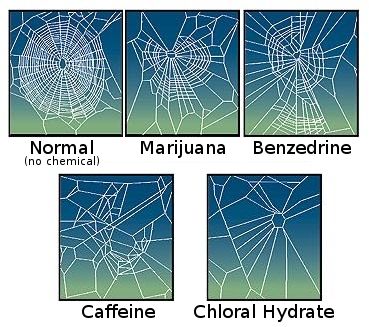
In 1948, a zookeeper wanted to observe spiders building webs, so he asked a druggist to give them something to make them build webs during the daylight hours. The idea didn’t work, but it opened the door to a different project. Pharmacologist Dr. Peter N. Witt was intrigued by the idea that spiders would built a different kind of web due to the drugs they ingested. Could this gimmick be made into a drug test? Or even a diagnostic tool?
It appears Witt imagined a world where all police departments and hospitals have a sort of spider lab. When a patient or inmate behaved strangely, that person's blood would be fed to a spider, which would then be left overnight to build a web. In the morning, a careful look at the spider's handiwork would provide answers. "Aha! My webs indicate this inmate over here is a laudanum addict, and this poor patient is suffering from schizoaffective disorder," a chin-scratching lab technician might have said.What did they learn? That spiders don't like drinking the urine of schizophrenics. Entomologists were not involved in the project, and they have a different view of the experiment. For one thing, spiders don’t react to drugs the same way humans do, and the way they spin their webs depends of a lot of different things, which you can read about at Vice.
"It obviously didn't work that well," Rayor told me. "That wasn't necessarily the end-all-and-be-all in terms of analyzing what kinds of drugs people had taken." Eventually technologies like mass spectrometry made Witt's spidergraph (my word, not his) unnecessary.

No comments:
Post a Comment